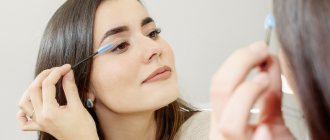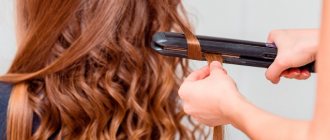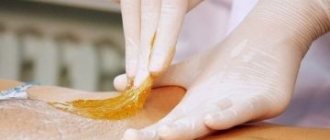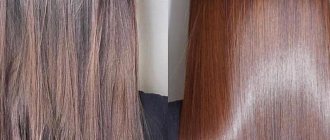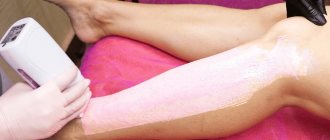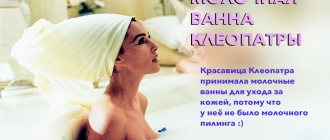Most women dream of long, thick and luxurious hair that looks no worse than the hair of Hollywood stars. Even though there are many assistants and stylists working on the hairstyles of movie actresses on film sets every minute of the film, the desire does not go away: every day we see a huge number of advertisements on TV, in magazines and on the Internet, in which ideal girls live their ideal lives, and each Of these, as a rule, he has chic hair with lush and attractive styling. But what to do if your hair does not naturally have incredible thickness and volume, and you don’t have the patience to grow it longer? In this case, hair extensions can come to the rescue, a service that is becoming increasingly popular and affordable.
There are several methods and types of hair extensions, which have their own pros and cons, and also differ significantly in price, convenience and time of the extension procedure itself. Some of these methods were invented relatively long ago and therefore have become morally obsolete, some, although already old and proven, turned out to be so successful that they are still used to this day and continue to delight new owners of luxurious hair. Each woman can decide for herself which method is most suitable for her and how much money she is willing to spend to achieve her goal.
What are hair extensions?
Which of us girls hasn’t dreamed of having a gorgeous head of hair, at least for a little while? However, most people are faced with the fact that growing long and thick curls is not an easy task, taking a lot of time, attention and effort.
I myself constantly intend to grow a “mane”, but every time I break down and cut off either a bob or a bob. The fact is that hair, in principle, grows quite slowly - an increase of one centimeter per month will not soon make you the owner of luxurious hair. In addition, the longer the hair, the more prone it is to hair loss, thinning and split ends . What should impatient people like me do if they want Disney's Rapunzel hairstyle right now? In this case, hair extensions in a salon will be a real salvation.
Hair extensions are the process of lengthening your own curls by attaching donor, artificial or natural ones to them. The main difference between extensions and wigs, hairpieces and removable hair extensions is the reliable fixation of the strands and the long-term result - without correction, extensions are worn for 2 to 4 months.
For the bravest! Extensions allow you to experiment not only with the length, but also with the shade of your hair - to do this, you can extend strands of a different color from your own, or even take extension strands of different colors to make your hairstyle look as creative as possible.
Who should get hair extensions?
Extensions are “shown” to all girls who are dissatisfied with the length and thickness of their own hair, who want to quickly change their image and acquire beautiful hair. But you need to keep in mind that extensions have some contraindications:
- dandruff , dermatitis and other scalp diseases;
- hair loss;
- hypersensitive scalp;
- poor hair condition - fragility , fragility, thinning strands;
- vascular diseases and blood pressure problems;
- tendency to headaches and migraines;
- chronic diseases requiring hormonal therapy or antibiotics;
- age up to 16 years;
- pregnancy and lactation period.
A number of points can be called safety nets. Indeed, from a scientific point of view, the procedure does not involve any harmful substances entering the bloodstream. But some conditions of the body make the skin more sensitive, which means that extensions and elements of their fastening are still less likely to cause allergies. Since the risk cannot be excluded one hundred percent, it is better to wait a little.
Contraindications
Despite the fact that the technique is safe and painless and involves the gradual attachment of additional hairs, the technique also has health restrictions, which are prescribed before work.
Restrictions on the state of hormonal levels are not prescribed, since the technology does not affect it. Because of this, Botox can be done during pregnancy, breastfeeding and menstruation.
Restrictions depend on the salon where you perform the procedure. But keep in mind the main prohibitions:
- Vegetative-vascular dystonia;
- Presence of skin damage on the sensitive surface of the head;
- Increased fragility and thinness;
- Severe allergic reaction;
- Taking antibiotics;
- Taking a course of chemical therapy.
The procedure can be performed safely from the age of 16, since it does not affect the client’s hormonal status. However, many cosmetologists may prohibit its implementation until the girl reaches adulthood. This allows natural hair to finally form, prevent its premature thinning and changes in the processes of the root system.
The original length of the hair is taken into account. It is not recommended to make the length too long to prevent heavy stress on the root system, which will spoil the health of natural hair.
With a length of up to 20 centimeters, do not make more than half a meter, with a length of up to 30 centimeters - no more than 60 centimeters, up to 40 - no more than 80 centimeters, up to 50 - no more than a meter. Do not make your hair longer than one meter, since, regardless of the initial state of the hair, this creates a greater load on the hair follicles to which additional inserts are attached.
Hair extensions: their pros and cons
Before you decide to get hair extensions, it is important to weigh the pros and cons. The main advantage here is the ability to quickly solve the problem of lack of curl length and volume, and change your image with virtually no damage to your hair. But there are several factors that for many are serious disadvantages of this procedure.
- Contraindications to extensions can become an obstacle for some girls to quickly achieving the hair of their dreams.
- Many are put off by the high cost of the first procedure and the need for regular hair correction.
- Unscrupulous hairdressers sin by using low-quality donor strands, as a result of which the hair extensions quickly lose their original appearance, begin to get tangled and even fall out.
- Owners of hair extensions may experience discomfort while wearing them, especially during sleep.
- With some types of hair extensions, hair cannot be heated above 100 degrees, as the donor strands may simply fall off.
- For weakened hair, extensions can have a negative effect and significantly worsen the already poor condition of the curls. Fortunately, this problem can be solved on your own: just add professional strengthening products to your care a few months before the procedure.
The best products for preparing hair for extensions according to SalonSecret:
- Kérastase Genesis range provides intense hydration, reduces breakage and hair loss, strengthens the structure and makes hair fuller.
- L'Oréal Professionnel Inforcer products contain a powerful mix of biotin and vitamin B6, which restores strength and elasticity to weakened strands.
- Redken Acidic Perfecting Concentrate lotion in combination with shampoo and conditioner makes hair noticeably stronger after the first use: it contains a restorative bonding complex and citric acid.
- And the formula of Matrix So Long Damage is rich in ceramides, which not only help reduce breakage and maintain length, but also the growth of new, stronger hair.
Creative
This is a youth method of hair extensions, depending on your flight of fancy and the professional capabilities of the specialist.
If you wish, you can at least put pink-leopard strands or Swarovski rhinestones on your head!
Or you can create several types of curls on your head at once - from corrugated hair to Senegalese braids - this is creative hair extensions.
Types of hair extensions
The result and final appearance of the hairstyle after a visit to the salon directly depends on what method the master chooses to attach the donor strands. We will talk about different techniques of female hair extensions and their features, the tools used and terms of wear below.
Capsule
From the name of this method it is clear that capsules are used in the extension process. It is with their help that donor curls are attached to the hair, divided into thin strands, in the root zone - the capsules are invisible, small in size and can be keratin, gel, resin or glue. There are also microcapsules, they are even more weightless. All capsule extension techniques are divided into hot and cold methods of attachment.
- Hot extension
In this case, the master uses tongs heated to 90–180 degrees, which melt the capsule connecting the native hair with the donor hair. The hot method has two popular varieties - the Italian technique and the English one. They differ from each other in the thickness of the strands, the composition of the connecting capsule, as well as its shape after heating.
With Italian extensions, the capsule consists of keratin and, after hardening, resembles an almost imperceptible flat plate. For the English technique, keratin resin is used as “glue” - after heating with tongs, it has the shape of a rounded grain.
A significant disadvantage of hot extensions is that the capsules cannot be heated: it is forbidden to wash your hair with very hot water, steam in a bathhouse or sauna, or style your curls with a curling iron or other thermal devices - all this can cause the capsules to melt and the extensions to fall out.
- Cold build-up
Cold extensions do not involve thermal effects on the hair, therefore it is considered safer for the health of the curls. The salon can offer you the following types of cold equipment:
- Spanish extensions (surgical glue is used to attach the strands);
- ultrasonic or Hollywood extensions (donor strands are fixed using keratin capsules and an ultrasound machine);
- Japanese extensions (to lengthen hair, metal clips 2–3 mm in size are used, with the help of which artificial hair is attached to the natural hair);
- Brazilian extensions (strands are attached to the hair by weaving donor hair with natural curls into a braid and fixing the connection with a synthetic thread, which is technically similar to dreadlocks and weaving with Kanekalons );
- gel extensions (the master attaches the false strands using a special gel and forms a fixing capsule himself).
Non-capsular
Capsuleless extensions differ from the previous type of hair extension in that they do not require the use of glue and capsules - the strands are fixed using heat-sensitive sleeves, into which both the natural hair and the extensions are placed, and then the sleeves are clamped with tongs heated to 120 degrees. What is attractive about this method: the attachment points are located on the back of the head and are completely invisible in appearance and to the touch. However, there is a drawback: you cannot heat the hairstyle above 100 degrees, as high temperatures can melt the sleeves.
Tape
Tape extensions are a gentle way to lengthen hair, when natural curls are fixed between two adhesive tapes with artificial strands. Tape extensions are often used to increase the thickness of thin and sparse hair ; it is suitable for lengthening bangs and very short strands, and due to the ultra-light weight of the tapes, it is also suitable for thinning, weakened curls. Correction of tape extensions does not take much time and is necessary every five to six weeks.
Tressovoye
Another gentle way to achieve the coveted length is to use hair extensions using tresses. Wefts are tufts of hair tightly stitched together and connected by one strip of fabric. They can be removable (attached with microclips and removed at any time if desired) or non-removable (the tresses are fixed to the braids or strands with special glue or sewing threads).
The most common tress length is from 40 to 70 cm.
Correction: how long does it last?
Advertising for long-term extensions promises girls long and thick hair for a period of 6-12 months. But in practice, the shelf life of extensions depends on many factors:
- quality of donor strands;
- professionalism of the technician who performed the extension;
- the state of one’s own hair, its reaction to extended curls.
In any case, mandatory hair correction is required every 1.5-3 months . To make the extensions look natural and invisible, they are attached as close to the scalp as possible. As her own curls grow, the girl’s line of attachment of donor strands shifts downward. This can expose the attachments for prying eyes and weaken the fixation of the donor curls.
The correction procedure consists of several stages:
- Transfer of donor curls to the desired location. To do this, the strand is removed, the fastening is renewed, and then the false curl is again fixed at a distance of a centimeter from the roots of the hair.
- Replacement of donor strands that have become unusable with new ones. High quality strands will last at least a year.
- If necessary, a haircut is done and the original and extended curls are trimmed to create a single harmonious image.
On a note! Some extension techniques prohibit dyeing the hair along with the donor material. In this case, coloring is carried out during correction.
It is necessary to take into account that the correction procedure can last even longer than the initial extension , since it includes both detachment and re-fastening of the donor strands.
What kind of hair can you use extensions on?
Thanks to the variety of techniques for attaching strands, extensions are designed for hair of very different lengths and structures. What nuances should be taken into account?
Long
View this post on Instagram
Posted by ERIC VAUGHN (@realericvaughn)
View this post on Instagram
Posted by ERIC VAUGHN (@realericvaughn)
It would seem that long curls do not need such a procedure as extensions. However, with the help of donor strands, you can not only solve the problem of lack of length, but also thicken your hair , make it more voluminous if your own strands are too thin; disguise signs of baldness; make bangs without cutting your length.
Average
View this post on Instagram
Posted by ERIC VAUGHN (@realericvaughn)
View this post on Instagram
Posted by ERIC VAUGHN (@realericvaughn)
Hair extensions for medium hair are one of the most popular services in salons. Very often, girls with hair of 15–20 cm who are tired of growing their curls or simply do not want to waste time and effort, but want to temporarily gain both length and thickness, turn to hair extension specialists. Before special events, when the hairstyle should become the accent of the image, hair extensions are especially appropriate.
The average length easily satisfies the requirements of the procedure, so the most popular extension techniques can easily be applied to an elongated bob, bob , cascade, shaggy and other haircuts length from the collarbone and slightly below.
Short
View this post on Instagram
Posted by ERIC VAUGHN (@realericvaughn)
View this post on Instagram
Posted by ERIC VAUGHN (@realericvaughn)
For girls with short hair, extensions are a great opportunity to radically change their image. However, you need to keep in mind that not all types of extensions are suitable for short hair: the strands on the top of the head should still allow you to hide the junction of your natural hair with the extensions. For example, the microcapsule technique allows you to work with hair from 5 cm in length, while English hot extensions require a minimum of 15 cm of native hair.
Curly
View this post on Instagram
Posted by ERIC VAUGHN (@realericvaughn)
View this post on Instagram
Posted by ERIC VAUGHN (@realericvaughn)
Not only straight, but also curly hair is suitable for extensions - curled false curls, usually of the Slavic type, are attached to them. The master chooses the technology depending on the condition of the hair, but most often it is the Spanish cold method, when the strands are fixed with a special glue, or the tape method of fastening.
How much does the best cost?
The cost of extension is calculated individually. The total amount will consist of several parameters:
- purchase of donor hair (taking into account the quality, total quantity, volume, length of strands), other necessary materials - adhesive composition, tapes, clips, rings for fastening;
- payment for the work of a master stylist (calculated taking into account the number of strands that need to be extended);
- the price for extensions differs in different regions of the country (usually in the provinces it is significantly cheaper than in big cities).
On average, approximate prices for extensions (at prices in large cities) are:
| Type of extension | Description of materials | price, rub. |
| Italian | Slavic hair, 45 and 50 cm long, 100 strands | 14000 |
| English | Slavic strands 40 cm long, 100 pieces | 8000 |
| Japanese | Strands of European origin, length 45 cm, 100 pieces | 7500 |
| Spanish | European donor material, 100 strands, 40 cm long | 8000 |
| Afro extension (French technique) | French tress extensions. For work we use European curls 40 cm long, 100 pieces | 8000 |
| Bellargo (microbellargo) | Slavic hair, use 100 strands 45 cm long | 23000 |
| Microcapsule | Slavic hair, use 100 strands 45 cm long | 25000 |
| Brazilian | Slavic hair, use 100 strands 40 cm long | 13000 |
The final cost of the procedure can only be determined with the help of a master stylist, who will subsequently perform the work.
How are hair extensions done?
We'll tell you how hair extensions work using the keratin capsule method as an example. This procedure takes from 3 to 5 hours, depending on the number of false strands.
- First of all, the client’s hair and scalp are washed well, and then the hair is dried with a hairdryer.
- The master determines the line of attachment of false hair and divides the entire mass of curls into thin strands.
- A donor strand is applied to the native hair and the bonding keratin capsule is heated with tongs.
- The craftsman uses his hands or tongs to shape the capsule into a spherical shape.
- After all donor strands are attached, the hair is straightened with an iron.
- Using a hot razor, the master evens out the transition area from natural hair to false hair.
- At the end, the final length and shape of the hairstyle is adjusted.
The extension procedure is quite labor-intensive and requires certain skills. Only an experienced hairdresser will correctly select the type of extensions, their length and method of attachment to the hair, properly carry out the procedure and fix the extensions. There is no need to talk about high-quality hair extensions at home - usually attempts to do hair extensions on your own end with noticeable attachments, tangling of donor strands and their loss.
Indications for implementation
Any girl can resort to the extension procedure, subject to the following conditions. Extensions are ideal for women with strong, “thick” hair, without a tendency to fall out or become brittle.
For owners of weak, thin strands, gentle technologies for attaching donor strands have been specially developed. A master stylist will help determine the possibility of extensions; in difficult cases, you may need to consult a doctor.
It is necessary that the minimum length of natural hair meets the requirements of the chosen extension technology. At a preliminary consultation, the master stylist will offer several extension methods, taking into account the length of the hair. If a girl has already made a choice in favor of one technology or another, but the length is not enough, her hair will have to be grown out first.
It is important to make sure that there are no contraindications to the procedure - the deplorable condition of your hair (severe hair loss, excessive fragility) or scalp (hypersensitivity, diseases of the epidermis).
Myths about hair extensions
View this post on Instagram
Posted by ERIC VAUGHN (@realericvaughn)
Today, there are a huge number of myths around extensions that prevent girls from making the final choice and deciding on this procedure. We decided to debunk the most popular of them.
- Myth 1. Hair extensions are very different from natural strands
In fact, for extensions, donor strands are used that are as close as possible in shade and structure to the client’s hair. To do this, take high-quality natural hair of the Slavic, Asian or European type.
- Myth 2. Hair extensions are attached using household glue.
Our main advice: do not turn to handicraftsmen! Salons that are concerned about their reputation and the health of their clients make high-quality hair extensions using keratin resin or surgical glue - these are hypoallergenic and safe fixing materials.
- Myth 3. Hair extensions spoil the condition of your natural hair.
Hair is harmed by non-compliance with technology during the extension process, untimely corrections and improper care of the extensions. If the extensions are performed by an experienced specialist, and the recommendations for caring for curls are strictly followed by the client, there is no risk of ruining the hair.
Longest lasting effect
When choosing a technique for lengthening curls, take into account the duration of the positive effect.
With the English and Italian method, the duration of the effect lasts up to 1.5-2 months. If you perform Spanish lengthening, the effectiveness will remain for up to six months. With tape extensions you can last 1-2 months, and ultrasonic extensions will last up to 8 weeks.
Features of caring for hair extensions
Even the most beautiful hair extensions will lose their appearance if you neglect the care rules for extensions. Here are the basic recommendations to keep your hair extensions in perfect condition for a long time.
Washing head
It is important to wash your hair after extensions very carefully and only with warm water at a comfortable temperature. Fixing capsules are damaged not only by too hot water, but also by intensively rubbing shampoo into the roots of the hair, so the cleanser must be applied evenly to the length and carefully rinsed off.
In addition, it is better to do this in the shower - you cannot lower your curls forward and down while washing, as this can lead to tangling of the strands.
Shampoo for hair extensions should not contain aggressive components. In this case, a gentle, SLS-free cleanser, such as Kérastase Fluidealiste .
Shampoo-bath Fluidealiste, Kérastase
More details
You will definitely need a mask or conditioner after washing. But do not forget that nourishing care products containing oils should be applied exclusively to the lower half of the length and ends of the curls, as they weaken the junction of the strands and can cause hair extensions to fall out.
Drying
After washing, you need to gently pat your hair with a towel and let it dry naturally. The use of a hair dryer is allowed only in extreme cases and only in a gentle mode at minimum power. To prevent split ends, hair stylists recommend applying a heat protectant to the ends, such as Redken Satinwear 04 .
But there will be no problems with styling on already dry hair. Do hairstyles of any complexity yourself or with the help of a stylist.
Combing
In order to avoid tangling of curls and the formation of tangles, you need to pay special attention to daily combing - hairdressers advise combing your hair extensions at least three times a day! In addition, not every comb is suitable for extensions.
- Firstly, the material from which the comb is made is important - it should be silicone, wood or natural bristles. Metal or plastic are not suitable, as they cause cracks in the capsules connecting the hair.
- Secondly, the teeth on the comb should be wide and sparse, and if we are talking about a brush, then choose a product with widely spaced bristles.
- Thirdly, at the ends of the teeth there should be no tips in the form of metal balls, which can damage the capsules and lead to separation of the strands.
How to comb your hair extensions correctly?
- Using your hand, gather your hair into a ponytail and hold it at the base of your head.
- Combing should begin from the ends, smoothly moving to the middle and lastly to the root zone.
- If tangles form during the process, use a detangling conditioner or a leave-in product, such as Matrix Moisture Me Rich Moisture Cure Redken Frizz Dismiss Anti-Static Disciplining Spray .
Summarize
Hair extensions are a great way to change your appearance or correct existing shortcomings:
- partially add volume to those places where it is necessary;
- thicken the ends;
- “dilute” your own shade with colored curls;
- get the desired length.
The disadvantages of the procedure include the high cost and duration of both primary attachment and correction (it takes even more time!). Also, do not forget that constant wearing of donor curls is not recommended. It is necessary to take breaks so as not to provoke the loss of your own hair.
Share with your friends!
more
Read us in the Zen channel
You can use hair extensions to give your bangs a test drive.
It’s difficult for many people to decide to get bangs because they fear that they won’t suit their face and they’ll have to grow them out in discomfort. To experiment and test drive a new look, you should resort to hair extensions. Moreover, modern masters offer to perform a procedure in which artificial hair is indistinguishable from your own, and no one will notice how it is attached.

